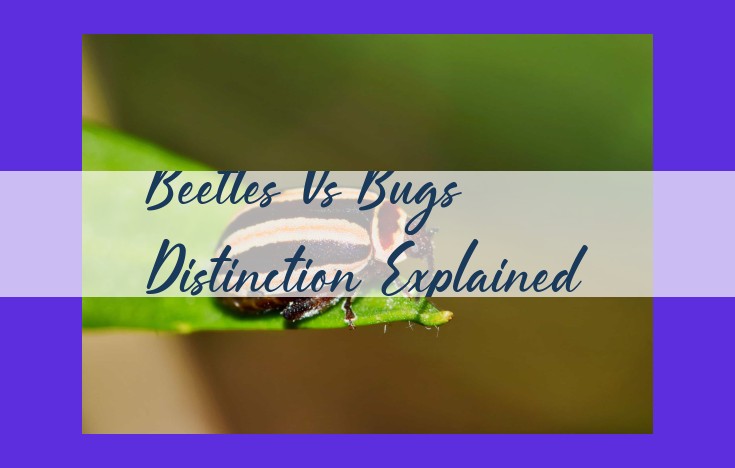In the realm of insects, beetles and bugs exhibit distinctive features that set them apart. Beetles are characterized by their protective elytra, which are modified forewings that shield their hindwings and abdomen. Their chewing mouthparts contrast with the piercing mouthparts of bugs. Additionally, beetle antennae are primarily sensory, while bugs often use theirs for feeding. Despite both having six legs, their structures and functions differ. Moreover, beetles undergo complete metamorphosis, transitioning through larval, pupal, and adult stages, unlike bugs that experience incomplete metamorphosis with nymph stages leading to adulthood.
Elytra: The Distinctive Feature of Beetles
In the vast and diverse world of insects, beetles stand out as a captivating group. A key feature that sets them apart from their buggy counterparts is the presence of elytra, a remarkable protective covering that has played a crucial role in their evolutionary success.
Defining Elytra
Elytra are the hardened forewings of beetles, modified to form a protective shield over their hindwings and abdomen. Unlike the membranous wings of bugs, elytra are thickened and leathery, providing beetles with an unparalleled level of protection against predators, environmental hazards, and physical damage.
Protection of Hindwings and Abdomen
The primary function of elytra is to safeguard the delicate hindwings and abdomen of beetles. When not in use, the hindwings are folded beneath the elytra, shielded from harm. This adaptation allows beetles to squeeze into narrow spaces, burrow underground, and withstand crushing forces that would otherwise cripple their membranous wings.
Adaptive Versatility
Beyond their protective role, elytra have also evolved to serve various adaptive functions in different beetle species. In some beetles, elytra have become fused, forming a solid, immovable covering. In others, they have evolved into spines, horns, or other defensive structures that deter predators or provide camouflage. This incredible versatility highlights the adaptive nature of elytra, contributing to the diverse and successful radiation of beetles across the globe.
Mouthparts: Chewing vs. Piercing
In the insect world, the battle of the bites is a tale of adaptation and survival. Beetles, with their armored exoskeletons, deploy a formidable set of chewing mouthparts, akin to miniature scissors. These specialized tools allow them to devour a wide array of organic matter, from plant tissues to decaying flesh. Their mandibles, the primary chewing blades, are often robust and asymmetrical, mirroring the strength and precision of their bite.
In contrast to beetles, bugs employ piercing-sucking mouthparts, perfectly suited for their liquid diets. These mouthparts resemble intricate straws, with elongated, needle-like mandibles and maxillae (upper and lower “lips”). Mosquitoes, for instance, use these specialized structures to puncture human skin and draw blood. Their piercing mouthparts function like tiny syringes, injecting saliva that acts as both an anesthetic and an anticoagulant.
The distinctions in mouthpart design reflect the diverse ecological niches occupied by beetles and bugs. Chewing mouthparts empower beetles to thrive as scavengers and predators, while piercing-sucking mouthparts enable bugs to exploit liquid-rich environments such as plant nectar and animal blood. These specialized adaptations are a testament to the remarkable diversity and ingenuity of insect life.
Wings: Elytra Function and Flight Abilities
In the realm of insects, the distinction between beetles and bugs extends to their flight capabilities and the unique adaptive features of their wings.
Beetles, renowned for their protective exoskeletons, possess a remarkable characteristic known as elytra. These hardened, leathery forewings serve not only as a shield for the delicate hindwings and abdomen but also contribute to the beetles’ distinct flight patterns. Elytra function as a protective casing, shielding the vulnerable hindwings from potential damage during crawling, burrowing, or other activities.
In contrast, bugs exhibit a more traditional wing structure, with two pairs of membranous wings. These wings, when not in use, fold neatly over the body, allowing for efficient movement through vegetation or confined spaces. The flight abilities of bugs are generally more agile and maneuverable compared to beetles, enabling them to navigate complex environments with precision.
Despite their varying wing structures, both beetles and bugs have adapted to their respective niches. Beetles, with their robust elytra, are well-suited for environments with limited space or potential hazards. Bugs, on the other hand, thrive in open areas where their agile flight allows them to traverse distances with ease.
This fascinating contrast in wing function exemplifies the remarkable diversity within the insect world, showcasing the intricate adaptations that have evolved to meet the challenges of different habitats and lifestyles.
Antennae: Sensory Structures with Diverse Functions
Antennas, those delicate appendages that adorn the heads of beetles and bugs, serve as vital sensory organs. In bugs, these structures are highly specialized for detecting a vast array of stimuli, including food, mates, and potential dangers. Their antennae are often adorned with hair-like receptors, enabling them to pick up on the faintest vibrations and chemical signals.
In contrast, beetles have antennae that are primarily associated with their intricate feeding behavior. Their antennae serve as miniature antennae, detecting the scent of potential food sources. The shape and structure of these antennae can vary greatly, depending on the specific dietary preferences of different beetle species.
One of the most fascinating aspects of beetle antennae is their role in courtship. In certain species, the antennae play a crucial role in attracting mates. For instance, male stag beetles have elaborate antennae that they use to engage in elaborate displays, sending signals to potential mates.
Overall, the antennae of beetles and bugs serve as remarkable sensory structures, each adapted to the unique ecological niches of these fascinating creatures. Their ability to detect a wide range of stimuli allows them to navigate their environments, find food, and reproduce successfully. By unlocking the secrets of these remarkable sensory organs, we gain a deeper appreciation for the diversity and adaptability of the insect world.
Legs: Six-Legged Champions with Specialized Roles
In the fascinating world of insects, beetles and bugs stand out as two of the most diverse and abundant groups. Among their myriad distinctions, their legs play a crucial role in their survival and success.
The Leggy Diversity
Beetles and bugs both possess six legs, as befits their insect heritage. However, digging deeper reveals remarkable differences in their leg structure and function. The legs of beetles are typically sturdy and robust, designed for a variety of tasks, including walking, digging, and climbing. In contrast, bugs have more slender and agile legs, tailored for tasks such as jumping, running, and grasping.
Specialized Structures for Unique Behaviors
The front legs of beetles are often modified for specific purposes. Some beetles have enlarged digging claws, enabling them to burrow through soil or wood. Others have adhesive pads on their feet, allowing them to cling to smooth surfaces. Bugs, on the other hand, typically have spiny or suction-cup-like structures on their front legs, allowing them to hold prey or anchor themselves firmly.
The middle legs of both beetles and bugs are generally used for walking. However, in some beetles, the middle legs are adapted for swimming or clinging to vegetation. In bugs, the middle legs can be modified for jumping or kicking.
The hind legs of beetles are often the most specialized. In some species, they are greatly elongated, enabling them to leap impressive distances. Others have spines or serrated edges, providing a formidable defense against predators. Bugs, on the other hand, often have strong jumping legs, allowing them to escape danger or reach their prey swiftly.
Metamorphosis: Complete vs. Incomplete Transformations
In the realm of insects, metamorphosis is a transformative journey that sculpts their appearance and capabilities. Beetles and bugs undergo distinct metamorphic paths, each tailored to their unique ecological niches.
Complete Metamorphosis in Beetles
Beetles, such as ladybugs and scarabs, embark on a dramatic metamorphosis that unfolds in four distinct stages: egg, larva, pupa, and adult. From the moment they emerge from their eggs, larvae resemble neither the pupae nor the adults. These “grubs” feed and grow voraciously, passing through several instars (molts) before entering a transitional phase known as the pupa. Within the protective confines of the pupa, a remarkable transformation unfolds. The larval structures dissolve, and the adult beetle takes shape, complete with hardened elytra, functional wings, and specialized mouthparts.
Incomplete Metamorphosis in Bugs
In contrast, bugs, such as grasshoppers and aphids, undergo an incomplete metamorphosis characterized by three stages: egg, nymph, and adult. Nymphs emerge from eggs bearing a striking resemblance to their adult counterparts. As they progress through multiple instars, they gradually acquire adult features while maintaining their overall form. Unlike beetles, bugs do not possess a pupal stage. Instead, nymphs directly molt into miniature versions of the adults, lacking only fully developed wings and reproductive organs.
Significance of Metamorphic Differences
The contrasting metamorphic processes of beetles and bugs reflect their divergent ecological adaptations. Complete metamorphosis in beetles allows for a more specialized adult stage, optimized for tasks such as flight and reproduction. The larval stage, free from the constraints of the adult form, can focus on feeding and growth. In contrast, incomplete metamorphosis in bugs promotes a gradual transition to adulthood, ensuring a consistent food source and protection throughout their development.
Understanding these metamorphic distinctions is crucial for comprehending the ecology and evolution of these fascinating insect groups. Beetles and bugs, with their unique metamorphic trajectories, play multifaceted roles in ecosystems, from pollination and decomposition to biological control.




